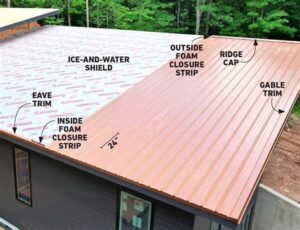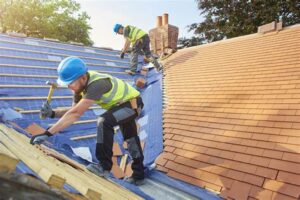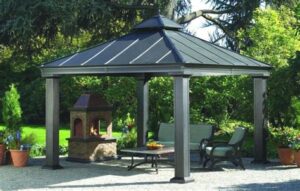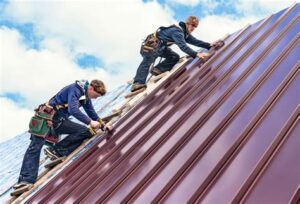When it comes to choosing the right roofing material for your home, copper and metal options have gained popularity for their distinctive qualities and numerous benefits. This article explores the pros and cons of copper and metal roofing, providing homeowners with essential insights to make an informed decision. From the long-term advantages of copper’s stunning aesthetics and durability to the cost implications of various metal materials, we’ll guide you through the key factors to consider. Additionally, we’ll discuss how metal roofing can enhance energy efficiency and ultimately lower your utility bills. By balancing the benefits against potential drawbacks, you’ll be empowered to choose the roofing solution that best meets your needs and budget. Let’s dive into the world of copper and metal roofing and discover what makes these materials stand out.
The Pros Of Copper Roofing: Long-Term Benefits For Homeowners
Copper roofing is renowned for its exceptional aesthetic appeal and durability, offering a range of long-term benefits that make it an attractive choice for homeowners. One of the significant pros of copper roofing is its longevity. Unlike other roofing materials, copper can last over 50 years, requiring minimal maintenance. As it weathers, it develops a beautiful patina that many find appealing, often enhancing the overall value of the property.
Another advantage is its resistance to various weather conditions. Copper roofs are highly resilient against wind, rain, and snow, making them ideal for regions with extreme weather. This durability not only protects the home but also reduces the likelihood of needing costly repairs or replacements in the future.
In terms of energy efficiency, copper roofing excels in reflecting sunlight, which can help maintain a cooler temperature in your home. This reflective property contributes to lower energy bills, especially during warm months, adding to the already significant long-term savings.
Additionally, copper is naturally antimicrobial, helping to inhibit the growth of mold, algae, and bacteria, which is beneficial for maintaining the structural integrity of your home. This quality ensures a cleaner, healthier environment and reduces the need for chemical treatments.
Using copper as a roofing material is also an environmentally friendly choice. It is 100% recyclable, and its longevity reduces the frequency of roof replacements, which can lead to less waste in landfills. Collectively, these factors highlight the pros of copper roofing, making it a wise investment for homeowners looking for a durable, efficient, and sustainable roofing option.
Understanding The Cost Implications Of Metal Roofing Materials
When considering roofing options, it’s essential to evaluate not only The Pros but also the associated costs of metal roofing materials. The initial investment in metal roofing might be higher than traditional materials, but this expense is often balanced by the longevity and durability of metal roofs.
Here are key cost-related factors to consider:
- Initial Costs: Metal roofing tends to have a higher upfront cost, typically ranging from $120 to $900 per square. However, this price varies depending on the type of metal (steel, aluminum, copper, etc.) and the roof’s complexity.
- Longevity: While the initial costs are significant, metal roofs can last 40 to 70 years, which means fewer replacements over time compared to traditional asphalt shingles, which generally last 15 to 30 years.
- Maintenance Costs: Metal roofs require less maintenance than other materials. Most metal roofing products come with warranties of 20-50 years, reducing potential long-term maintenance expenses.
- Energy Savings: Metal roofing reflects heat, which can lead to lower energy bills during hot months, translating to significant savings over time.
- Time of Installation: Metal roofing can often be installed more quickly than traditional options, potentially saving on labor costs. However, it’s crucial to hire experienced professionals to ensure proper installation.
While the initial expense of metal roofing can be daunting, it’s vital to weigh these costs against the long-term benefits. Understanding these implications can help you make a well-informed decision that aligns with both your budget and long-term value considerations.
Durability And Longevity: The Pros Of Choosing Metal Roofing
When considering a roofing material, durability and longevity are crucial factors that many homeowners prioritize. One of the significant pros of metal roofing is its exceptional lifespan compared to traditional roofing materials. Metal roofs can often last 40 to 70 years with proper maintenance, significantly outpacing asphalt shingles, which typically last around 15 to 20 years. This long lifespan translates to fewer roof replacements over time, ultimately saving homeowners money in the long run.
Additionally, metal roofs are resistant to various weather conditions, including high winds, hail, and heavy snowfall. Their robust nature means they are less likely to suffer damage from adverse weather, allowing them to maintain their integrity and appearance for decades. Furthermore, metal roofing is typically non-combustible, offering enhanced fire resistance, which is an essential aspect for many homeowners, especially in areas prone to wildfires.
An essential advantage of metal roofing is its minimal maintenance requirements. Most metal roofing materials do not require extensive upkeep; regular inspections and cleaning are generally sufficient to keep them in optimal condition. This ease of maintenance contributes further to the overall longevity of the roof.
Choosing metal roofing offers significant pros in terms of durability and longevity. By investing in a metal roof, homeowners can enjoy peace of mind knowing that their roof will withstand the test of time while also ensuring safety and reducing long-term costs.
Energy Efficiency: How Metal Roofing Can Lower Your Bills
When considering the The Pros of metal roofing, one of the standout benefits is its energy efficiency. Metal roofs reflect solar radiant heat, which can significantly reduce cooling costs in the summer. In areas with high temperatures, this reflective quality can make a noticeable difference in how hard your air conditioning system has to work, thereby lowering energy bills.
Moreover, metal roofing systems often have a higher thermal emittance and reflectivity compared to traditional roofing materials. As a result, homes with metal roofs tend to maintain cooler indoor temperatures, which is not only beneficial for comfort but also for energy consumption. This feature is especially advantageous when paired with proper insulation. When combined, these factors can contribute to substantial savings over time.
Additionally, many metal roofing products are now available in various colors and styles that are specifically designed to enhance energy efficiency. For instance, choosing lighter colors can further enhance solar reflectance, promoting an even greater decrease in heat absorption.
Opting for metal roofing is a smart decision for homeowners looking to improve energy efficiency and ultimately reduce their monthly utility bills. Understanding these benefits is crucial when weighing the The Pros and cons of roofing materials.
Balancing The Pros And Cons: Making An Informed Roofing Choice
When considering a new roofing system, it’s crucial to weigh The Pros and cons of each option available to you. Copper and metal roofing systems are increasingly popular due to their unique benefits, but they also come with certain drawbacks that homeowners must contemplate. By understanding both sides, you can make a decision that best suits your home’s needs and your personal criteria.
First, it’s essential to list the key advantages and disadvantages of copper and metal roofing:
- The Pros: Durability, Energy efficiency, and Long-term cost savings often make copper and metal roofing appealing choices. Their longevity means fewer replacements over time.
- The Cons: Higher initial costs and potential noise during rain or hail storms can deter some homeowners. The installation process also requires professional expertise, which may further increase expenses.
Next, consider your specific situation:
- Climate: Will your area experience severe weather conditions? Metal roofs are known for their resilience against extreme weather, making them a reliable choice in such environments.
- Aesthetics: Are you aiming for a particular look? Copper roofing can add a distinctive elegance, whereas metal roofing offers various colors and styles to match your home’s aesthetic.
- Budget: Determine your budget for both installation and long-term maintenance, as the initial investment needs to be weighed against your financial strategy for home upkeep.
Deciding between copper and metal roofing requires careful consideration of The Pros against potential downsides. Consulting with professionals and gathering localized information can aid in making a more informed choice that aligns with your goals for your home. Balancing these factors will ensure you choose the best roofing solution for your needs.
Frequently Asked Questions
What are the main benefits of using copper roofing?
Copper roofing is highly durable, can last over 100 years, offers excellent weather resistance, and develops a protective patina that adds aesthetic value and minimizes maintenance needs.
How does metal roofing compare to traditional roofing materials?
Metal roofing is generally lighter, offers better durability, can reflect heat to improve energy efficiency, and has a longer lifespan compared to traditional materials like asphalt shingles.
Are there any environmental advantages to choosing copper or metal roofing?
Yes, both copper and metal roofing are recyclable, and their energy efficiency can reduce heating and cooling costs, minimizing the carbon footprint over their lifetime.
What are the downsides of having a copper roof?
Copper roofing can be significantly more expensive than other materials, may require specialized installers, and can be subject to certain building codes or restrictions due to its value.
How does the cost of metal roofing compare to other options?
Metal roofing can have a higher upfront cost compared to asphalt shingles, but its longevity and lower maintenance costs can result in savings over time.
What maintenance do copper and metal roofs require?
Both types of roofing generally require minimal maintenance, but periodic inspections are recommended to check for damage, debris buildup, or corrosion, especially in coastal areas.
Can copper and metal roofing affect home resale value?
Yes, homes with copper or high-quality metal roofing often see increased resale value due to their durability, unique appearance, and energy efficiency, attracting potential buyers.





